People who have had a good look at a sasquatch have no doubt at all about what they have seen, even if they can't give it a name. They know that a large, upright, fur-covered, and ape-like animal, whatever it may be called, exists because they have seen one. One example of such an observation, complete with its backstory, follows. Four similarly detailed eyewitness accounts have been set down in chapter 5 (Recent Accounts) in The Discovery of the Sasquatch: Reconciling Culture, History and Science in the Discovery Process. Five older published historical accounts, some of which are also remarkably detailed, are set down in chapter 4 (Historical Accounts) and date back to 1851.
Mica Mountain, British Columbia: October 1955
William Roe observed a large animal as he entered a clearing on Mica Mountain on a sunny afternoon in October 1955:
I saw what I thought was a grizzly bear in the bush on the other side. I had shot a grizzly near that spot the year before. This one was only about seventy-five yards away, but I didn’t want to shoot it, for I had no way of getting it out. So I sat down on a small rock and watched, my rifle in my hands….A moment later it raised up and stepped out into the opening. Then I saw it was not a bear….My first impression was of a huge man…almost three feet wide….But as it came closer I saw by its breasts that it was female.
And yet its torso was not curved like a female’s. Its broad frame was straight from shoulder to hip. Its arms were much thicker than a man’s arms, and longer, reaching almost to its knees. Its feet were broader proportionately than a man’s….
The nose was broad and flat. The lips and chin protruded farther than its nose. But the hair that covered it…made it resemble an animal as much as a human….and its neck was also unhuman, thicker and shorter than any man’s I had ever seen.
As I watched this creature, I wondered if some movie company was making a film at this place and that what I saw was an actor, made up to look partly human and partly animal. But as I observed it more, I decided that it would be impossible to fake such a specimen….
The thought came to me that if I shot it, I would possibly have a specimen of great interest to scientists the world over….
I levelled my rifle…[but after the creature turned to look in my direction] I lowered it. Although I have called the creature ‘it,’ I felt now that it was a human being and I knew I would never forgive myself if I killed it.
Roe watched the animal leave the clearing, walk into a stand of lodgepole pine and reappear briefly as it walked down a ridge.
I wanted to find out if it lived on vegetation entirely or ate meat as well, so I went down and looked for signs. I found it in five different places, and although I examined it thoroughly, could find no hair or shells of bugs or insects. So I believe it was strictly a vegetarian. I found one place where it had slept for a couple of nights under a tree.
William Roe subsequently related these details in a sworn legal statement which he made two years after his encounter. He concluded by stating
Whether this was a Sasquatch I do not know. It will always remain a mystery to me unless another one is found. I hereby declare the above statement to be in every part true, to the best of my powers of observation and recollection.1
——
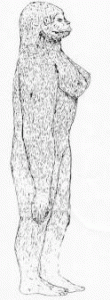 It is important to note that Roe had supported his family by hunting and trapping, so it was not surprising that he followed up his sasquatch observations by looking for sign.
It is important to note that Roe had supported his family by hunting and trapping, so it was not surprising that he followed up his sasquatch observations by looking for sign.
In looking for physical sign, Roe was in effect testing the hypothesis that the animal he had observed was a real or extant North American mammal, rather than an imaginary being or a hallucination. By finding scat and evidence of bedding-down, he found support for his assumption that it was indeed real (or corporeal) rather than imaginary (or incorporeal).
Certain aspects of Roe’s description of the animal observed warrant additional comment. For example, Roe concluded that the sasquatch observed was a female, based on protuberant “breasts” (figure 3.2, A). Other sasquatches have subsequently been described as females, similarly on the basis of observable “breasts,” or because the sasquatch appeared to be carrying an infant (figure 3.2, B and C).2
Although the sasquatch observed by William Roe appeared to be a female, most sasquatches observed appear to have been mature males, based on large size and broad shoulders (figure 3.3). Other sasquatches have been described as having a slimmer build—tall but thin. These likely represent subadults or young adults (figure 3.4). Upright juvenile sasquatches under four feet in height have also been described, although no eyewitness sketches have yet become available.3
Eyewitness descriptions and sketches of sasquatches as putatively male, female, adult, subadult, and juvenile support the interpretation of the sasquatch as a “normal” (or “real”) mammal species with a population structure consisting of both sexes and various age classes. As illustrated in a subsequent chapter (chapter 6), track evidence also suggests a range of foot size, variation which is also consistent with the sasquatch as a normal wildlife species, occurring as a number of North American populations or subpopulations.
In addition, Roe’s description provides a list of anatomical features which easily differentiate the sasquatch he observed from a bear, and more importantly, from a human:
Huge size: “My first impression was of a huge man…almost three feet wide.”
Long arms: “Its arms were much thicker than a man’s arms, and longer, reaching almost to its knees.”
Hair-covered body: “But the hair that covered it…made it resemble an animal as much as a human.”
Short, thick neck: “And its neck was also unhuman, thicker and shorter than any man’s I had ever seen.”
Flat face with short nose: “The nose was broad and flat. The lips and chin protruded farther than its nose.”
Broad feet: “Its feet were broader proportionately than a man’s.”
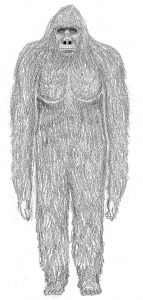
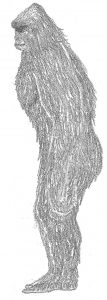
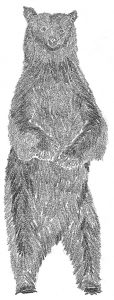
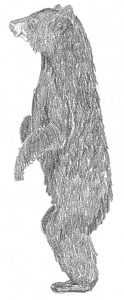 Roe’s conclusion that he was not looking at a bear, as he first thought, is illustrated in field guide drawings first prepared for the 1998 book: North America’s Great Ape: the Sasquatch.(A wildlife biologist looks at the continent’s most misunderstood large mammal.) It was reproduced in The Discovery of the Sasquatch: Reconciling Culture, History and Science in the Discovery Process. The absence of images such as these from state, provincial, and continental field guides (and from regional mammal lists) continues to be a powerful statement forbidding the sasquatch (or bigfoot) as a credible explanation of a sasquatch observation or “sighting.”
Roe’s conclusion that he was not looking at a bear, as he first thought, is illustrated in field guide drawings first prepared for the 1998 book: North America’s Great Ape: the Sasquatch.(A wildlife biologist looks at the continent’s most misunderstood large mammal.) It was reproduced in The Discovery of the Sasquatch: Reconciling Culture, History and Science in the Discovery Process. The absence of images such as these from state, provincial, and continental field guides (and from regional mammal lists) continues to be a powerful statement forbidding the sasquatch (or bigfoot) as a credible explanation of a sasquatch observation or “sighting.”